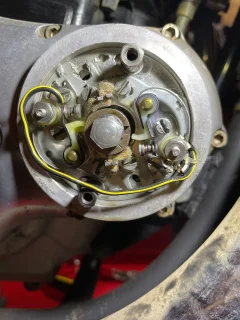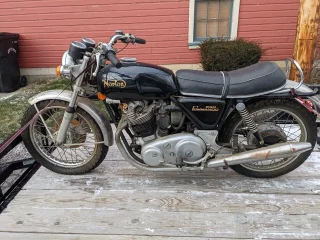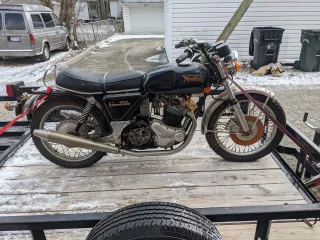Hello everyone!
I have a 1973 Norton Commando 850 and I have been trying to set the ignition timing by adjusting the points.
Here is my current process:
1. Take spark plugs out and remove exhaust and intake valve covers
2. Remove the port window on the primary chain case cover that displays the static degree plate and engine timing mark
3. With the bike in neutral, slowly move the kick until I see the left piston's intake opens and closes and piston rises
4. Now that I believe I am on the compression stroke of the left cylinder, I look for the timing mark in the primary chain case and align it on the 28° mark on the black plate by putting the bike in gear and turning the rear wheel
5. Once the timing mark is perfectly on the 28° mark, I now move to the points assembly
6. In the points assembly, I look to see if a points set heel is in-line with the scribe on the points cam and set gap
This is where I find the problem, the points cam scribe mark is far off from the points heel, and there is not enough adjustment capabilities on the points assembly and plate to get them to align.
Why would this happen?
Why would things get so far off?
Is this a normal problem over time?
Am I messing up the procedure somewhere?
Attached is a photo of how far off the scribe line is from a heel, this is with one piston at (to the best of my knowledge) BTDC at the 28° mark on the compression stroke.
Thank you all for your time!
I have a 1973 Norton Commando 850 and I have been trying to set the ignition timing by adjusting the points.
Here is my current process:
1. Take spark plugs out and remove exhaust and intake valve covers
2. Remove the port window on the primary chain case cover that displays the static degree plate and engine timing mark
3. With the bike in neutral, slowly move the kick until I see the left piston's intake opens and closes and piston rises
4. Now that I believe I am on the compression stroke of the left cylinder, I look for the timing mark in the primary chain case and align it on the 28° mark on the black plate by putting the bike in gear and turning the rear wheel
5. Once the timing mark is perfectly on the 28° mark, I now move to the points assembly
6. In the points assembly, I look to see if a points set heel is in-line with the scribe on the points cam and set gap
This is where I find the problem, the points cam scribe mark is far off from the points heel, and there is not enough adjustment capabilities on the points assembly and plate to get them to align.
Why would this happen?
Why would things get so far off?
Is this a normal problem over time?
Am I messing up the procedure somewhere?
Attached is a photo of how far off the scribe line is from a heel, this is with one piston at (to the best of my knowledge) BTDC at the 28° mark on the compression stroke.
Thank you all for your time!




